Plants
Dragon Tree Care Guide – Easy & Effective Tips

Welcome to our Dragon Tree care guide! If you’re a plant enthusiast or looking to add some greenery to your indoor space, the Dragon Tree (Dracaena marginata) is an excellent choice. With its striking striped leaves and low-maintenance nature, this timeless plant is sure to bring beauty and freshness to any room.
In this guide, we will provide you with easy and effective tips on how to care for and grow your very own Dragon Tree. From light requirements and watering tips to pruning techniques and propagation, we’ve got you covered. Let’s dive in and discover the secrets to keeping your Dragon Tree healthy and thriving.
Key Takeaways:
- Dragon Trees, or Dracaena marginata, are popular indoor plants known for their slender striped leaves.
- They thrive in bright indirect light but can adapt to different lighting conditions.
- Water your Dragon Tree when the topsoil is dry, and let it dry out between waterings to avoid overwatering.
- Fertilize your plant during the spring and summer months to promote growth and health.
- Regular pruning and cleaning of your Dragon Tree will help maintain its health and appearance.
Light Requirements for Dragon Trees
Dragon Trees, also known as Dracaena marginata, are versatile indoor plants that can adapt to various lighting conditions. Understanding their light requirements is vital for ensuring their health and growth.
Dragon Trees thrive in bright indirect light, making them perfect for rooms with ample natural light. Placing them near a north or east-facing window allows them to receive the ideal amount of light without being exposed to direct sunlight. This helps prevent leaf scorching, which can damage the plant’s foliage.
However, Dragon Trees can also tolerate lower light levels, making them suitable for rooms with medium to low indirect light. They can adapt to various lighting conditions and still thrive, making them an excellent choice for homes or offices with less than ideal light exposure.
Remember, too much direct sunlight can be harmful to Dragon Trees and cause their leaves to burn. It’s important to find the right balance between light and shade to ensure their well-being.
Tip: To determine if your Dragon Tree is receiving the right amount of light, observe its leaves. If they appear vibrant and healthy, it means they are getting enough light. However, if the leaves start to fade or become pale, it may indicate that the plant needs more light.
| Light Level | Description |
|---|---|
| Bright Indirect Light | Ideal for Dragon Trees, provides the perfect balance of light and shade. |
| Medium Indirect Light | Tolerable for Dragon Trees, suitable for rooms with moderate natural light. |
| Low Indirect Light | Acceptable for Dragon Trees, appropriate for rooms with limited natural light. |
| Direct Sunlight | Avoid exposing Dragon Trees to direct sunlight as it can scorch their leaves and cause damage. |
Watering Tips for Dragon Trees
When it comes to caring for your Dragon Tree, proper watering is essential to ensure its health and longevity. Understanding the watering needs of your plant and implementing the right techniques can make a significant difference in its overall well-being.
So, how do you water a Dragon Tree effectively? First and foremost, it is crucial to water the plant when the topsoil feels dry to the touch. This usually occurs once a week, but it may vary depending on environmental factors such as temperature and humidity.
Allowing the plant to dry out between waterings is essential to prevent overwatering, which can lead to root rot and other complications. It’s always better to underwater than overwater, as Dragon Trees are more tolerant of dry conditions.
Pro Tip: To help you determine the right time to water, you can use a moisture meter to monitor the soil humidity. This handy tool takes the guesswork out of watering, ensuring that you provide the right amount of moisture for your Dragon Tree.
During the winter months, when the plant is dormant, the watering frequency may decrease. This is because the plant’s growth slows down, and it requires less water. As a general rule, water the Dragon Tree every 2-3 weeks during this period, or when the top inches of soil are dry.
Remember, every plant is unique, and factors like the size of the pot, the type of soil, and the environmental conditions in your home can affect watering requirements. It’s important to observe your Dragon Tree closely and adjust the watering schedule accordingly.
To summarize, here’s a quick overview of the watering tips for your Dragon Tree:
- Water the plant when the topsoil is dry to the touch, usually once a week.
- Allow the plant to dry out between waterings to avoid overwatering.
- Use a moisture meter to monitor soil humidity and ensure optimal watering.
- Adjust the watering frequency during the winter months when the plant is dormant.
By following these watering tips, you can provide your Dragon Tree with the right amount of moisture it needs to thrive. Remember, maintaining a proper watering routine is just one aspect of caring for your Dragon Tree, so stay tuned for more helpful tips in our Dragon Tree Care Guide.
Growth Rate of Dragon Trees
Dragon Trees are known for their slow growth but constant leaf production. As indoor plants, they can reach heights of up to eight feet, transforming any space into a lush and vibrant environment.
To promote optimal growth and health, it is important to provide your Dragon Tree with the necessary nutrients. Fertilizing the plant 1-2 times a month during the spring and summer with indoor plant food can significantly enhance its growth rate. This regular fertilization provides your Dragon Tree with the essential nutrients it needs to thrive.
By providing your Dragon Tree with the right conditions and care, you can ensure that it reaches its maximum potential, adding a touch of natural beauty to your indoor space.
| Key Factors for Dragon Tree Growth | Optimal Conditions |
|---|---|
| Light | Bright indirect light or low to medium light levels |
| Watering | Allow topsoil to dry out between waterings |
| Fertilization | 1-2 times a month with indoor plant food during spring and summer |
| Pruning | Regularly remove dry or dead leaves throughout the year |
Common Problems with Dragon Trees
While the Dragon Tree is generally a resilient plant, it can encounter some common issues that may affect its overall health and appearance. Understanding these problems and addressing them promptly is key to keeping your Dragon Tree thriving. Here are a few problems you may encounter:
1. Dragon Tree Leaves Falling Off
The natural shedding of leaves is a normal occurrence for Dragon Trees. It’s not uncommon to find fallen leaves on the floor or at the base of the soil. However, if you notice an excessive amount of leaves falling off or if the plant starts to look bare, it may indicate an underlying issue.
2. Dragon Tree Leaves Drooping
Drooping leaves can be a sign of overwatering or underwatering. If your Dragon Tree’s leaves are wilting or hanging down, it’s important to assess the watering habits. Overwatering can lead to root rot, while underwatering can cause dehydration and stress.
3. Dragon Tree Leaves Turning Brown
Browning of the leaves can be a result of several factors, including underwatering, overfertilization, excessive sunlight exposure, or temperature fluctuations. It’s essential to find the underlying cause and adjust the care accordingly to prevent further discoloration.
To maintain the health of your Dragon Tree and address these common problems, here are a few tips:
- Prune any dead or damaged leaves regularly to promote new growth and improve overall appearance.
- Ensure you are watering your Dragon Tree correctly. Allow the topsoil to dry out between waterings to avoid overwatering.
- Monitor the lighting conditions and make sure your Dragon Tree is not exposed to direct sunlight.
- Keep the plant away from drafts and temperature extremes.
By taking these simple steps, you can help your Dragon Tree overcome common problems and maintain its beauty and vitality.
Pruning and Cleaning Dragon Trees
Regular pruning of dry or dead leaves is essential for the overall health and appearance of your Dragon Tree. It is recommended to prune throughout the year, focusing on minor pruning tasks, and save major pruning for the spring and summer seasons when the plant is actively growing. By removing dead or dying leaves, you are allowing the plant to redirect its energy towards new growth and maintain its aesthetic appeal.
Cleaning the leaves of your Dragon Tree is also important to ensure its health and vibrancy. Over time, dust can accumulate on the leaves and hinder the plant’s ability to absorb sunlight and effectively photosynthesize. To clean the leaves, gently wipe them with a moist towel or soft cloth. This will help remove dust particles and keep the foliage looking refreshed.
In addition to cleaning the leaves manually, misting the plant on a regular basis can also aid in maintaining a clean and healthy Dragon Tree. Misting helps to remove dust and provides a humid environment, which the plant appreciates.
Remember, a clean and well-pruned Dragon Tree not only looks appealing but also contributes to its overall well-being. By implementing regular pruning and cleaning practices, you can enjoy a thriving and beautiful Dragon Tree in your indoor space.
| Benefits of Pruning and Cleaning Dragon Trees | How to Prune and Clean Dragon Trees |
|---|---|
|
|
Repotting Dragon Trees
Repotting a Dragon Tree every 2-3 years with fresh soil is an essential part of caring for this magnificent plant. Not only does it provide the plant with essential nutrients, but it also encourages new growth and ensures the longevity of your Dragon Tree. Here, we will guide you through the process of repotting your Dragon Tree to maintain its health and vitality.
When repotting a Dragon Tree, it is important to choose a pot that allows for proper root growth and drainage. Select a pot that is one size larger than the current container, ensuring it has drainage holes to prevent excess water accumulation.
The repotting process involves several simple steps:
- Carefully remove the Dragon Tree from its current pot. Gently loosen the soil around the edges of the pot to ease the plant’s removal.
- Shake off the excess soil from the roots, being careful not to damage them. Check the roots for any signs of damage or disease and trim if necessary.
- Place a layer of fresh, well-draining potting soil at the bottom of the new pot.
- Position the Dragon Tree in the center of the new pot, ensuring that the roots are spread out evenly.
- Add more potting soil around the roots, gently firming it in place to provide stability.
- Water the newly repotted Dragon Tree thoroughly, allowing the excess water to drain out from the bottom of the pot.
Once repotted, it is important to give your Dragon Tree some time to adjust to its new environment. Place it in a well-lit area away from direct sunlight, and avoid disturbing the plant for a few days to allow it to acclimate to its new surroundings.
Remember: Each Dragon Tree is unique, so it is crucial to monitor its growth and adjust the repotting frequency as needed. If the plant becomes root-bound or starts showing signs of stress, such as stunted growth or unhealthy foliage, consider repotting it before the recommended timeframe.
Repotting your Dragon Tree is a rewarding task that promotes its overall health and ensures its continued growth and beauty. By following these simple steps, you can provide your Dragon Tree with the optimal growing conditions it needs to thrive for years to come.
Propagating Dragon Trees
Propagating Dragon Trees is a rewarding and simple process that allows you to expand your indoor garden. By following the steps of water propagation, you can easily create new Dragon Tree plants from existing ones.
To propagate a Dragon Tree, you will need:
- A healthy Dragon Tree plant
- Sharp, sterilized pruning shears or a clean knife
- A clean glass or jar filled with water
- Potting soil
- A new pot with drainage holes
Here’s a step-by-step guide on how to propagate a Dragon Tree:
- Select a healthy branch or stalk from your existing Dragon Tree plant for propagation.
- Using sterilized pruning shears or a clean knife, make a clean cut just below a node or leaf base. Ensure the cutting is at least 6 inches long, and remove any leaves from the lower half of the cutting.
- Place the cutting in a clean glass or jar filled with water, making sure that the bottom portion is submerged while the upper part remains above the waterline.
- Find a location for the glass or jar where it will receive bright, indirect light. Avoid placing it in direct sunlight, as it can harm the cutting.
- Change the water every 2-3 days to prevent stagnation and ensure the cutting receives fresh water.
- Within a few weeks, you should start to see roots developing from the submerged portion of the cutting.
- Once the roots are a few inches long, carefully transfer the cutting into a pot filled with well-draining potting soil. Make a small hole in the soil, gently place the rooted cutting into it, and lightly pack the soil around the base to secure it.
- Water the newly potted cutting thoroughly, allowing any excess water to drain out through the pot’s drainage holes.
- Place the potted cutting in an area with bright, indirect light and maintain regular watering and proper drainage to support its growth.
With proper care and attention, your newly propagated Dragon Tree will take root and grow into a healthy, vibrant plant. Remember to monitor its water, light, and nutrient needs as it continues to thrive.
Propagation Tips:
Here are a few tips to increase your chances of success when propagating Dragon Trees:
- Choose a healthy and disease-free branch or stalk for propagation.
- Keep the cutting in a warm and humid environment to encourage root development.
- Avoid overwatering the cutting, as it can lead to root rot. Maintain moist but not waterlogged soil for optimal growth.
- Consider using a rooting hormone to promote faster root development.
Example Dragon Tree Propagation Table:
| Propagation Method | Advantages | Disadvantages |
|---|---|---|
| Water Propagation |
|
|
By following these simple steps and propagation tips, you can successfully propagate your Dragon Trees and enjoy the satisfaction of growing new plants from your existing ones.
Dragon Tree Varieties
Dragon Trees come in various captivating varieties, each displaying unique characteristics and colors. Let’s explore two popular types:
Dracaena marginata ‘Tricolor’
The Dracaena marginata ‘Tricolor’ is a stunning dragon tree variety known for its red margins, green leaves, and an elegant ivory stripe. The vibrant red hues add a pop of color to any indoor space, making it a popular choice among plant enthusiasts.
Dracaena marginata ‘Colorama’
Another captivating variety is the Dracaena marginata ‘Colorama.’ This dragon tree showcases striking variegated leaves with beautiful pink, white, and green stripes. Its vibrant color combination adds a touch of liveliness to any room, creating a visually appealing focal point.

These dragon tree varieties offer a wide range of colors and patterns to suit different preferences and interior design styles. Whether you prefer the bold red accents of the ‘Tricolor’ or the vibrant variegation of the ‘Colorama,’ these dragon tree varieties are sure to enhance the beauty of your indoor space.
Conclusion
In conclusion, Dragon Trees are a fantastic choice for plant enthusiasts looking to add beauty and greenery to their indoor spaces. With their striking striped leaves and easy care requirements, these plants can thrive and enhance any living space.
By providing your Dragon Tree with the right amount of light, watering it appropriately, and implementing regular pruning and maintenance, you can ensure its health and vitality for years to come. Remember to keep it in bright, indirect light, water it when the topsoil is dry, and remove any dead or dry leaves as needed.
With proper care, your Dragon Tree will continue to grow and flourish, purifying the air and adding a touch of elegance to your home or office. So go ahead and incorporate this beautiful plant into your indoor decor – you won’t be disappointed! Caring for dragon trees and fiddle leaf figs involves a few similar fiddle leaf fig care strategies. Both plants prefer bright, indirect light and well-draining soil. They also benefit from regular watering, allowing the soil to dry out slightly between waterings. Additionally, they thrive in warm, humid environments. Dragon Trees prefer bright indirect light but can also adjust to medium to low light levels. It is important to keep them away from harsh direct sunlight, as it can scorch their leaves. The Dragon Tree should be watered when the topsoil is dry, usually once a week. It is important to let the plant dry out between waterings to avoid overwatering. During the winter months, the watering frequency may be less frequent. Dragon Trees are slow growers but constantly produce new leaves while shedding old ones. Indoors, they can reach heights of up to eight feet. The Dragon Tree naturally sheds its leaves, so it is not uncommon to find them on the floor or at the base of the soil. However, if the plant is losing many leaves or showing signs of distress, it may indicate a problem such as overwatering or temperature fluctuations. Pruning dead leaves and ensuring proper watering can help maintain the plant’s health. Regular pruning of dry or dead leaves is recommended throughout the year, with major pruning best done in spring and summer. Cleaning the leaves with a moist towel and misting the plant to remove dust can help keep the Dragon Tree healthy and vibrant. Repotting a Dragon Tree every 2-3 years with fresh soil provides essential nutrients and encourages new growth. It is important to choose a pot that allows for proper root growth and drainage. The repotting process involves removing the plant from the pot, shaking off old soil, placing it in a new pot with fresh soil, and giving it time to adjust to its new environment. Yes, Dragon Trees can be propagated easily through water propagation. This involves cutting a branch or stalk, placing it in water until roots develop, and then transferring it to potting soil. Watering and drainage should be maintained to ensure successful propagation. Dragon Trees come in different varieties, including Dracaena marginata ‘Tricolor’ with red margins, green leaves, and an ivory stripe, and Dracaena marginata ‘Colorama’ with variegated pink, white, and green stripes. These varieties offer unique colors and can be selected based on personal preference. Dragon Trees can be grown outdoors in warmer climates. They should be planted in well-draining soil and provided with partial shade. Outdoor Dragon Trees may require more frequent watering and protection from extreme weather conditions.What Similarities Exist in Caring for Dragon Trees and Fiddle Leaf Figs?
FAQ
How much light do Dragon Trees need?
How often should I water my Dragon Tree?
How fast do Dragon Trees grow?
What should I do if my Dragon Tree is losing a lot of leaves?
How do I prune and clean my Dragon Tree?
When should I repot my Dragon Tree?
Can I propagate my Dragon Tree?
What are some different varieties of Dragon Trees?
How do I care for an outdoor Dragon Tree?
- About the Author
- Latest Posts
Meet Bethia, the visionary designer at ByRetreat who brings a touch of magic to every remote workspace she creates. With a boundless imagination and an eye for beauty, Bethia is passionate about transforming ordinary spaces into extraordinary havens of creativity and comfort.
Bethia possesses a unique talent for envisioning the perfect combination of furniture, colors, and textures that harmonize seamlessly in a room. She understands that selecting furniture goes beyond mere functionality; it’s about curating pieces that evoke a sense of style and sophistication while enhancing the overall ambiance.
Plants
Ideal Hydrangea Spots: Best Place to Plant Hydrangeas
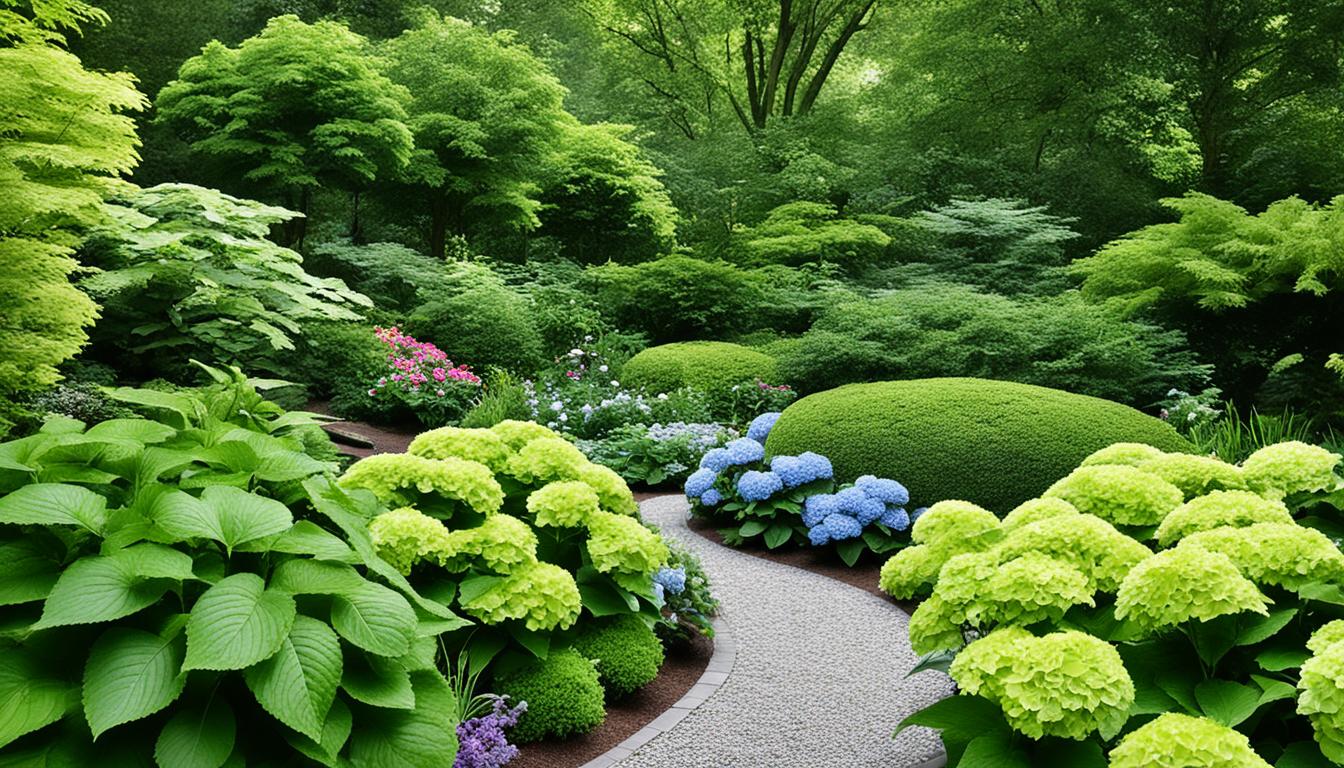
Did you know that the location where you plant your hydrangeas can have a significant impact on their growth and vibrancy? Finding the best place to plant hydrangeas is essential for optimal growth and to ensure that you get the most beautiful blooms.
In this guide, we will explore the different factors to consider when selecting the ideal spot for your hydrangeas. Whether you have a sunny garden or a shady corner, we’ll help you choose the right hydrangea varieties to thrive in various sun and shade conditions. By understanding their sunlight preferences and caring for them properly, you can enjoy vibrant and healthy hydrangea blooms year after year.
Key Takeaways:
- Choosing the right location is crucial for the growth and vibrancy of hydrangeas.
- Hydrangeas can thrive in different sunlight conditions, from full sun to partial shade.
- Consider the specific sunlight needs of different hydrangea varieties for optimal results.
- Proper care, including pruning, fertilizing, and watering, is essential for healthy blooms.
- By following our planting guide and care tips, you can transform your garden with stunning hydrangea displays.
Hydrangeas for Part Shade: Give Us Some Sunblock Please
When it comes to creating the perfect environment for hydrangeas, finding the right balance of sun and shade is key. While some hydrangea varieties thrive in full sun, others prefer a location with partial shade, where they can benefit from the morning sun and enjoy relief from the scorching afternoon rays. These hydrangeas are like beachgoers who know the importance of sunblock, seeking a little shade to protect themselves from the intense heat.
In the family of hydrangeas, there are several popular cultivars that are well-suited for part shade conditions. These varieties have the ability to produce stunning blooms when provided with a combination of filtered light and a few hours of full sun. Among them are the beloved Endless Summer® Hydrangea series, which includes BloomStruck®, Endless Summer®, Blushing Bride®, and Twist-n-Shout®.
Another great choice for morning sun and afternoon shade is the Annabelle Hydrangea, which is known for its spectacular large white flowers. And let’s not forget the many bigleaf hydrangea cultivars that can handle part shade and reward you with their vibrant blossoms.
Here are a few remarkable hydrangea varieties that thrive in part shade:
| Hydrangea Variety | Light Requirements |
|---|---|
| Endless Summer® series (BloomStruck®, Endless Summer®, Blushing Bride®, Twist-n-Shout®) | Morning sun, afternoon shade |
| Annabelle Hydrangea | Morning sun, afternoon shade |
| Bigleaf hydrangea cultivars | Morning sun, afternoon shade |
These hydrangeas have adapted to thrive in part shade by enjoying the gentle morning sun and being sheltered from the intense afternoon heat. This combination of light conditions allows them to produce their enchanting blooms and add a touch of elegance to any garden or landscape.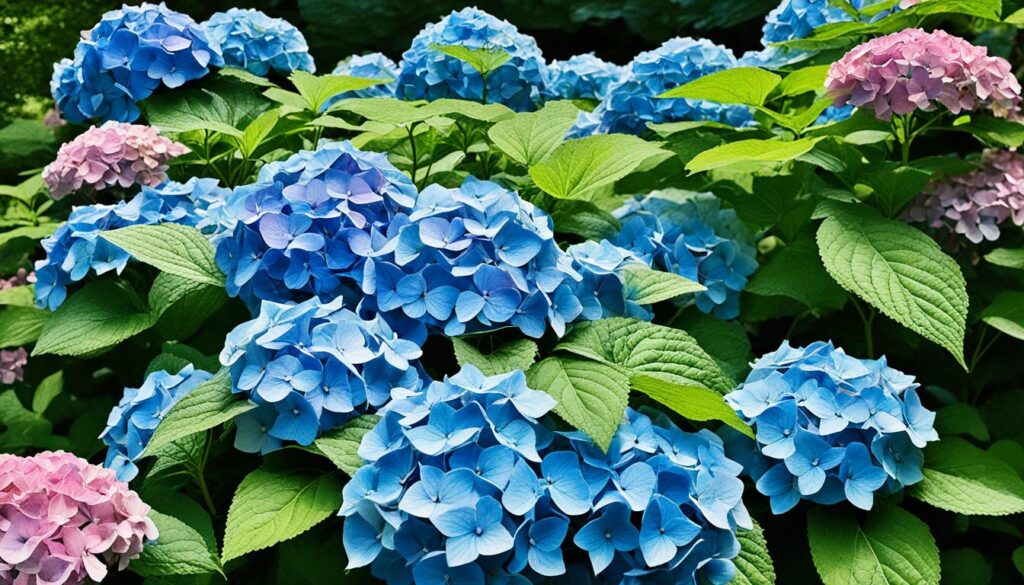
So, if you have a garden or yard with a mix of sunlight and shade, don’t worry! There are plenty of beautiful hydrangeas that will thrive in this environment. Just give them some sunblock (in the form of morning sun) and watch as their blooms light up your space with their breathtaking beauty.
Hydrangeas for Full Sun: We Like It Sunny
While most hydrangeas prefer some shade, there are certain varieties that can thrive in full sun. If your garden gets plenty of sunlight, don’t worry! There are hydrangeas that will flourish in these conditions and reward you with beautiful blooms.
Panicle Hydrangeas
Panicle hydrangeas, known for their cone-shaped flower clusters, are excellent choices for full sun exposure. They can tolerate the direct heat and intense sunlight, making them perfect for sunny spots in your garden. Some popular panicle hydrangeas include:
- Fire Light®
- Limelight
- Pinky Winky®
- Strawberry Sundae®
- Vanilla Strawberry®
Dwarf Varieties
If you have limited space or prefer compact hydrangeas, consider the Let’s Dance® and Cityline® series. These dwarf varieties are perfect for both full sun and part sun environments. They offer the beauty of hydrangeas in a smaller package without compromising on vibrant blooms.
Smooth Hydrangeas
Smooth hydrangeas are another type that can handle full or part sun conditions. These varieties are known for their large rounded flower heads and are a great choice for a sunny garden. Consider the following smooth hydrangeas:
- Incrediball®
- Invincibelle® Ruby
With these hydrangeas, you can enjoy the beauty and charm of these flowering plants even in full sun areas. Just make sure to provide them with proper care and maintenance, including regular watering and occasional fertilization.
Overall, including hydrangeas that thrive in full sun can add a splash of color and vibrancy to your garden. Whether you choose panicle hydrangeas, dwarf varieties, or smooth hydrangeas, these sun-loving beauties will brighten up any sunny corner of your outdoor space.
Growing Hydrangeas in Different Sun and Shade Conditions
When it comes to growing hydrangeas, understanding their sunlight requirements is essential for their success. While many hydrangea varieties thrive in partial shade, oakleaf hydrangeas are known for their adaptability to different sun and shade conditions.
In the northern parts of the United States, oakleaf hydrangeas can tolerate full sun. However, in warmer and southern climates, they prefer some afternoon shade to protect them from excessive heat and sun exposure. This makes them an excellent choice for those looking to plant hydrangeas in regions with varying temperature and sunlight conditions.
What makes oakleaf hydrangeas unique is their ability to also tolerate full shade. This makes them ideal for areas of the garden that receive little to no direct sunlight. Whether it’s a densely shaded corner or underneath taller trees, oakleaf hydrangeas can thrive and add beauty to areas that are typically challenging for other hydrangea varieties.
It’s important to note that while oakleaf hydrangeas are the most adaptable, other hydrangea varieties have specific sunlight needs. When selecting the location for planting, it’s crucial to consider the specific requirements of each hydrangea type to ensure optimal growth and vigor.
By carefully assessing the sunlight conditions in your garden and selecting the appropriate hydrangea varieties, you can create a diverse and captivating display of hydrangeas that thrive in different sun and shade conditions.
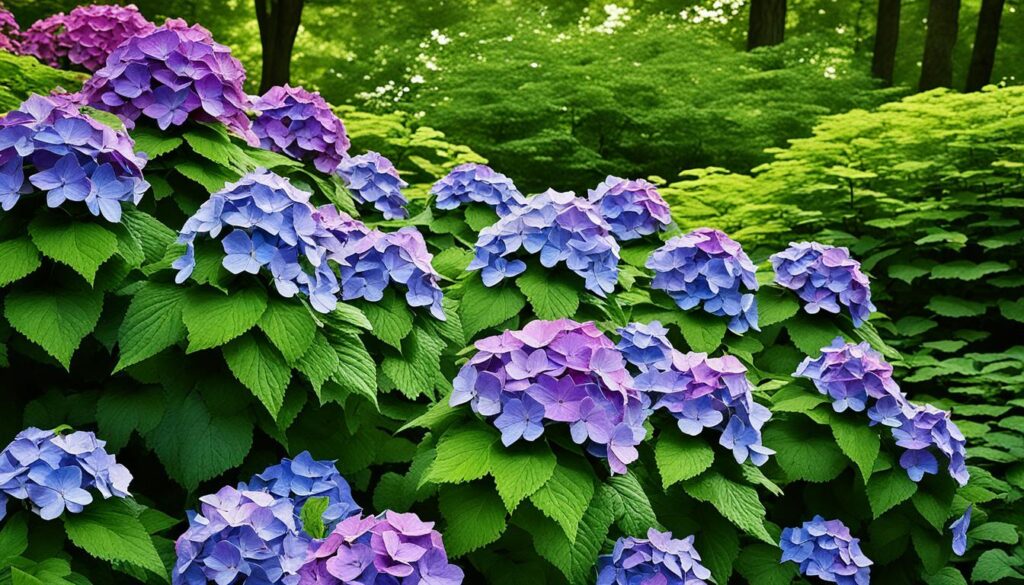
Pruning and Caring for Hydrangeas
Proper pruning and care are essential for the health and vitality of hydrangeas. By implementing appropriate pruning techniques and providing the necessary care, gardeners can ensure the longevity and abundant blooming of their hydrangea plants. Here are some important tips to consider:
Understanding Pruning Methods
When pruning hydrangeas, it’s crucial to understand whether the plant blooms on old wood or new wood. This knowledge will help gardeners avoid accidentally cutting off next season’s flowers.
Tip: Prune hydrangeas that bloom on old wood immediately after flowering. This allows for new growth and development of flower buds for next year. On the other hand, hydrangeas that bloom on new wood can be pruned during late winter or early spring before new growth begins.
Optimal Soil Conditions
Hydrangeas thrive in well-drained soil that is rich in organic matter. A mixture of compost and native soil is ideal for providing the necessary nutrients and moisture retention.
Fertilizing for Healthy Blooms
To promote healthy blooming, it’s recommended to fertilize hydrangeas with a slow-release fertilizer that is high in phosphorus. Phosphorus is essential for promoting flower production and overall plant vitality.
Preventing Leaf Scorch
Hydrangeas are susceptible to leaf scorch, especially during hot and dry periods. To prevent leaf scorch, it’s important to provide hydrangeas with extra water and ensure they have adequate moisture in the soil.

Summary of Pruning and Care Tips
| Pruning Method | Soil Conditions | Fertilizing | Preventing Leaf Scorch |
|---|---|---|---|
| Prune hydrangeas that bloom on old wood immediately after flowering | Well-drained soil with organic compost | Use slow-release fertilizer high in phosphorus | Provide extra water during hot and dry periods |
By following these pruning and care tips, hydrangea enthusiasts can enjoy lush, vibrant blooms year after year. With proper maintenance, these stunning plants will continue to beautify gardens and landscapes.
Conclusion
Planting hydrangeas in the best location and providing proper care and maintenance are key to achieving beautiful and vibrant blooms. By selecting the right spot that balances sun and shade, ensuring well-drained soil, and following recommended pruning and watering practices, gardeners can enjoy the full potential of their hydrangea plants. With the right planting and care, hydrangeas can transform any garden into a colorful and inviting space.FAQ
What is the best place to plant hydrangeas?
What are the best types of hydrangeas for morning sun and afternoon shade?
Can hydrangeas grow in full sun?
Which hydrangea varieties are best for full shade?
How should I prune and care for hydrangeas?
Are there any tips for planting and caring for hydrangeas?
- About the Author
- Latest Posts
Meet Katherine, the creative enthusiast at ByRetreat who infuses her boundless passion for design into every remote workspace she crafts. With an innate sense of creativity and an eye for unconventional beauty, Katherine brings a unique and inspiring perspective to the team.
Katherine’s love for design is infectious, and her ability to think outside the box sets her apart. She believes that true artistry lies in embracing a variety of styles and mixing them harmoniously to create captivating spaces. By combining different textures, colors, and patterns, Katherine weaves a tapestry of creativity that breathes life into each remote workspace.
Plants
Grow Zucchini Successfully: Best Way & Tips

Did you know that zucchini plants are susceptible to squash vine borers, a pest that can quickly kill the plants by cutting off the flow of water? The impact of these destructive borers can be devastating to your zucchini harvest. However, by following the best practices and tips for growing zucchini, you can ensure successful cultivation and enjoy a bountiful harvest.
Whether you are a seasoned gardener or a novice looking to try your hand at gardening, this article will provide you with valuable insights on the best way to grow zucchini and tips for successful cultivation. From avoiding squash vine borers to proper planting techniques, soil requirements, spacing, and pollination, we will cover everything you need to know to grow zucchini successfully.
Key Takeaways:
- Delay planting zucchini until mid-July or use row covers to prevent squash vine borers
- Start zucchini from seeds or seedlings and choose the right time to plant
- Provide well-draining soil enriched with organic material for optimal growth
- Space zucchini plants at least 3-4 feet apart and consider trellising for better air circulation
- Ensure proper pollination for optimal fruit production and harvest zucchini at any size
Planting and Germination
Zucchini, a popular summer squash variety, can be easily grown from seeds or seedlings. While starting zucchini indoors is an option, direct sowing in the ground is the preferred and most common method of planting zucchini seeds. Here’s a step-by-step guide to planting zucchini seeds and ensuring successful germination:
1. Prepare the Soil
Before starting zucchini indoors or sowing the seeds outside, it’s crucial to have well-prepared soil. Ensure the soil is loose, rich in organic matter, and drains well. Incorporating compost or aged manure can greatly improve the soil’s fertility. Measure the soil temperature and wait until it consistently reaches above 55 degrees Fahrenheit for successful germination.
2. Planting Zucchini Seeds
When the soil is ready, plant the zucchini seeds about an inch deep into the soil. Space the seeds at least 3 feet apart to allow ample room for growth. Lightly mist the top of the soil with water to ensure proper moisture levels for the germination of zucchini. Take care not to overwater the seeds, as it can lead to rotting.
Pro Tip: For those who prefer starting zucchini indoors, plant the seeds in peat pots or biodegradable seed starting trays about 2-3 weeks before the last expected frost. Transplant the seedlings outdoors once the soil temperature is suitable.
3. Germination and Thinning
The germination period of zucchini seeds typically ranges from 5 to 10 days. During this time, it’s important to keep the soil consistently moist but not waterlogged. Once the seedlings reach a height of around 3 inches and develop 2 sets of true leaves, it’s time to thin them out. Starting zucchini indoors often leads to more seedlings, so removing the weaker ones will allow the strongest ones to flourish.
4. Timing is Key
For optimal growth, it’s crucial to plant zucchini at the right time. Zucchini thrives in warm soil, so direct sowing should take place in the second half of May when the risk of frost has passed and the soil has warmed up. This timing ensures that the young seedlings will not succumb to cold temperatures.
“Direct sowing zucchini seeds is the most practical and successful method for home gardeners. The plants quickly establish themselves and produce abundant healthy foliage and fruit.” – Gardening Expert, Jessica Washington
By following these planting zucchini seeds and germination guidelines, you can give your zucchini plants a head start in their growth journey. Whether you choose to start the seeds indoors or directly sow them in the ground, with proper care and attention, you’ll soon be rewarded with healthy zucchini plants ready to produce an abundance of delicious squash.
| Benefits of Direct Sowing Zucchini Seeds | Benefits of Starting Zucchini Indoors |
|---|---|
| 1. Simplifies the planting process | 1. Provides an earlier start to the growing season |
| 2. Minimizes transplant shock | 2. Offers more control over seedling development |
| 3. Allows seeds to germinate and grow in their natural environment | 3. Enables better protection against adverse weather conditions |
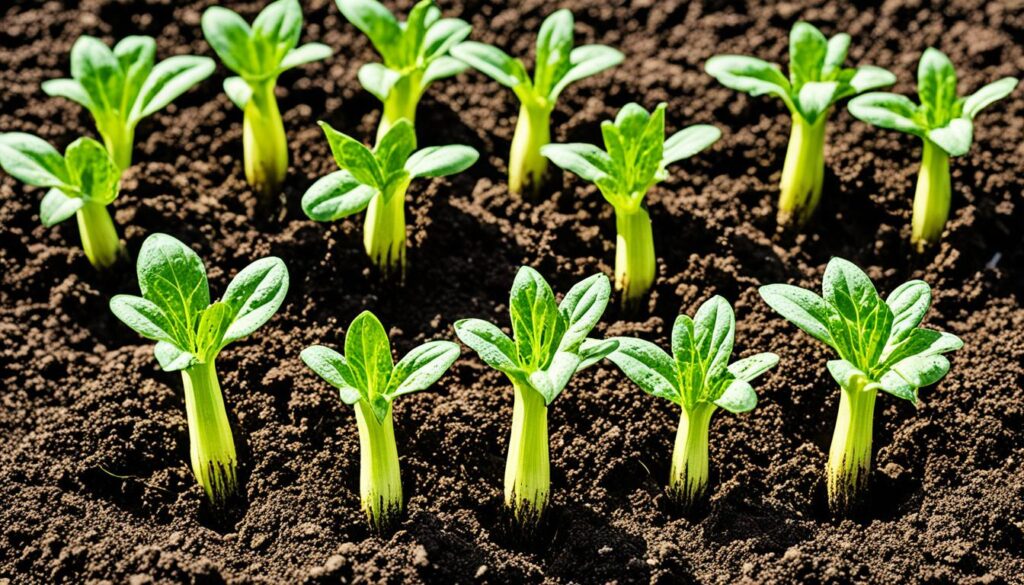
Soil and Location Requirements
Zucchini plants require specific soil and an ideal location to thrive and produce a bountiful harvest. Providing the right conditions for your zucchinis will ensure their health and productivity.
Choosing the Best Soil
Zucchini plants prefer organically rich, fertile, and well-draining soil. When planting in raised beds or containers, it is essential to select a well-draining potting soil. To enhance the soil’s fertility, add organic material or compost at the time of planting. This will help create a nutrient-rich environment for the zucchini plants to thrive.
If you are planting zucchinis directly in the ground, it is crucial to amend the soil with rich organic material or compost. This will improve the soil’s texture and provide the necessary nutrients for the plants to grow strong and healthy. Additionally, good drainage is essential for zucchini plants, as they prefer moist but not waterlogged conditions.
Choosing the Ideal Location
When selecting a location for your zucchini plants, it is important to consider their sunlight requirements. Zucchinis thrive in areas that receive full sun for at least 6-8 hours a day. Choose an area in your garden that is not shaded by buildings or trees, as this can hinder their growth and development.
Furthermore, it is important to note that zucchinis should not be planted in soil where other cucurbits (such as pumpkins or cucumbers) were grown in the past 1-2 years. This practice helps prevent the spread of diseases and pests that may affect the zucchini plants.
By providing the right soil conditions and selecting an ideal location with ample sunlight, you will create an optimal environment for your zucchini plants to flourish and produce an abundant crop.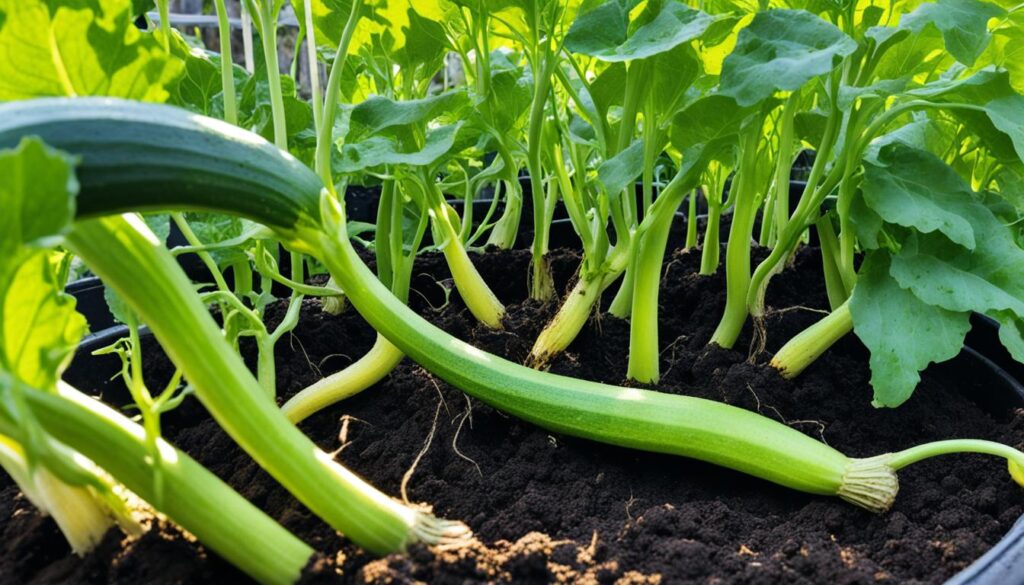
“Zucchini plants prefer organically rich, fertile, and well-draining soil. Provide the right conditions to help your zucchini plants thrive and produce a bountiful harvest.”
Spacing and Trellising
Proper spacing and trellising techniques are essential for the successful growth and development of zucchini plants.
Spacing Zucchini Plants
When it comes to zucchini plant spacing, giving enough room for each plant is crucial for optimal growth. It is recommended to space zucchini plants at least 3-4 feet apart, whether planting them in hills or rows.
For planting in hills, a general guideline is to plant 3 zucchinis per hill in a triangle pattern. Ensure the hills are also spaced 3-4 feet apart to provide enough space for the plants to receive nutrients and expand their root systems.
If growing zucchinis in containers, create a mound in the center of the container and plant three zucchinis around it. This arrangement allows for adequate airflow and efficient use of space while providing the plants with the necessary growing area.
Trellising Zucchini
Another option for maximizing space and aiding in pest management is trellising zucchini plants. By training them to grow vertically along a trellis or stakes, you can create a visually appealing and space-saving garden.
When trellising zucchini, ensure that the trellis or stakes are sturdy enough to support the weight of the plants and their fruit. As the zucchinis grow, gently guide the vines and tendrils toward the trellis, securing them with twist ties or plant clips.
The benefits of trellising zucchini include improved air circulation, which helps prevent disease, easier harvesting, and reduced pest damage since the plants are elevated off the ground.
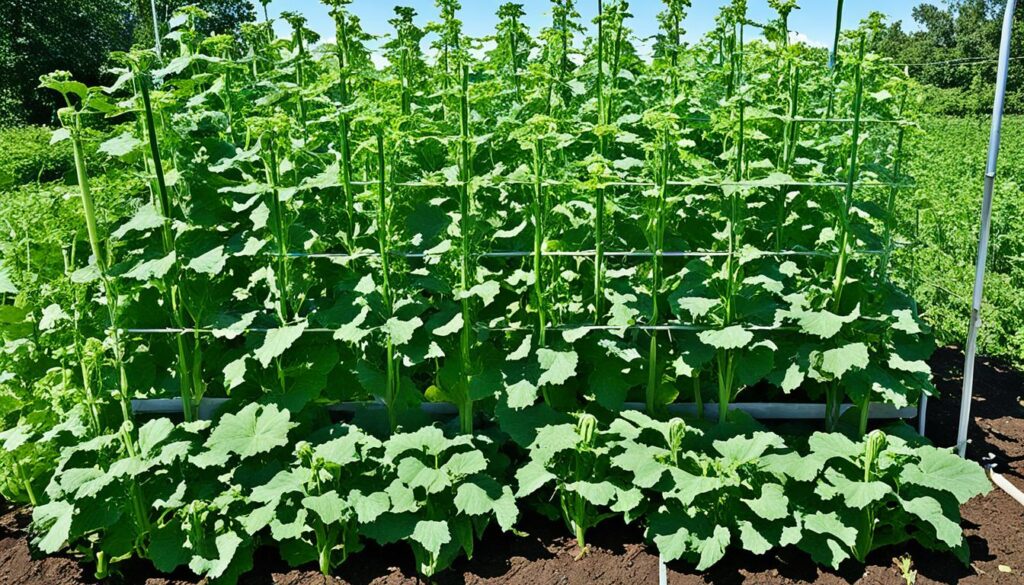
Implementing proper spacing and trellising techniques ultimately promotes healthier zucchini plants, increased productivity, and efficient use of garden space.
Pollination and Fruit Production
Zucchini plants rely on pollination for fruit production. These plants have separate male and female flowers, and the transfer of pollen from the male to the female flowers is crucial for the development of zucchini fruits. To ensure successful pollination, it’s important to understand how pollinators play a role in this process. 
Pollinators such as bees, butterflies, and other insects are attracted to the bright yellow flowers of zucchini plants. To maximize their presence in your garden, consider planting companion flowers like borage, catmint, dill, or dahlias nearby. These flowers will help attract pollinators, increasing the chances of successful pollination.
In some cases, there may be a lack of natural pollination due to factors such as weather conditions or a limited number of pollinators in the area. In such situations, manual pollination can be done to ensure fruit production. This process involves using a small brush or cotton swab to transfer pollen from the male flowers to the female flowers. By gently brushing the inside of the male flower and then transferring the pollen to the stigma of the female flower, you can help facilitate pollination.
Tip: To identify male and female flowers, look for the presence of a small zucchini-shaped swelling at the base of the female flower. Male flowers, on the other hand, do not have this swelling.
Proper pollination is essential for optimal fruit development. It ensures that the female flowers receive the necessary pollen for fertilization, leading to the formation of healthy zucchini fruits. Be sure to monitor the progress of your zucchini plants and check for signs of fruits developing from the female flowers.
When it comes to harvesting zucchini, you can do so at any size. However, larger zucchinis may have more developed seeds and a denser texture, which might not be desirable for certain recipes. In such cases, it is recommended to remove the seeds before consumption. This can be done by slicing the zucchini lengthwise and scooping out the seeds with a spoon.
Conclusion
Successful zucchini cultivation requires attention to several key factors, including avoiding squash vine borers, following proper planting techniques, providing the right soil and location, spacing plants correctly, and ensuring proper pollination. By implementing these tips and techniques, gardeners can enjoy a bountiful harvest of zucchinis that can be incorporated into a wide range of dishes.
The best way to grow zucchini is to start by carefully timing the planting, ensuring that soil temperatures are consistently above 55 degrees Fahrenheit. This warm soil temperature provides an ideal environment for germination and growth. Additionally, choosing a well-lit area with full sun for at least 6 hours a day will help zucchinis thrive.
When it comes to soil and location requirements, zucchini plants prefer organically rich and well-draining soil. Amend the soil with compost or rich organic material to promote healthy growth. Adequate spacing is essential for proper plant development, with a recommended distance of 3-4 feet between plants. Trellising zucchini plants can also save space and improve airflow.
Finally, ensuring proper pollination is crucial for maximizing fruit production. Planting companion flowers near zucchinis can attract beneficial pollinators, and manual pollination can be done to supplement natural pollination. Harvesting can be done at any size, but larger zucchinis may require seed removal before consumption.FAQ
When is the best time to plant zucchini?
How can I prevent squash vine borers from killing my zucchini plants?
What type of soil do zucchini plants prefer?
How should I space my zucchini plants?
Do zucchini plants require manual pollination?
Can I grow zucchini vertically?
- About the Author
- Latest Posts
Meet Katherine, the creative enthusiast at ByRetreat who infuses her boundless passion for design into every remote workspace she crafts. With an innate sense of creativity and an eye for unconventional beauty, Katherine brings a unique and inspiring perspective to the team.
Katherine’s love for design is infectious, and her ability to think outside the box sets her apart. She believes that true artistry lies in embracing a variety of styles and mixing them harmoniously to create captivating spaces. By combining different textures, colors, and patterns, Katherine weaves a tapestry of creativity that breathes life into each remote workspace.
Plants
Best Conditions for Ginger Root Growth Explained
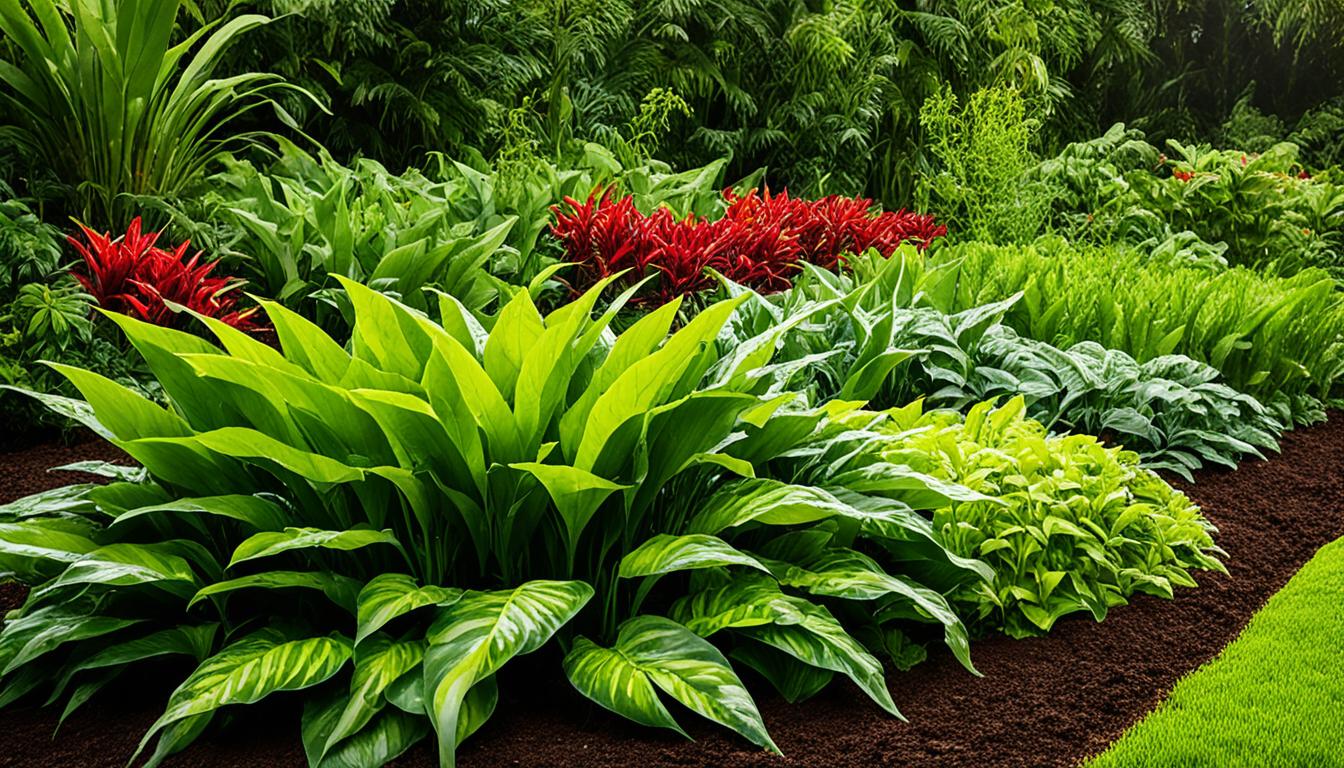
Ginger, known for its unique flavor and medicinal properties, is a versatile root used in everything from cooking to herbal remedies. But did you know that the success of ginger cultivation depends heavily on the conditions in which it is grown? Creating the best conditions for ginger root growth is essential to yield a bountiful harvest and vibrant plants.
From temperature to soil quality and moisture levels, each aspect plays a crucial role in ginger’s growth and well-being. By understanding the optimal conditions, gardeners and enthusiasts can replicate ginger’s tropical habitat and cultivate healthy plants with exceptional flavor and aroma.
In this article, we will explore the optimal conditions necessary for ginger root growth, offering insights and techniques to help you grow ginger successfully. Whether you’re an experienced gardener or a beginner with a green thumb, this guide will provide valuable knowledge to enhance your ginger cultivation.
Key Takeaways:
- Ginger root growth requires specific conditions to thrive.
- Temperature, soil quality, moisture, and shade are essential factors.
- Best practices include using organic matter, maintaining proper drainage, and providing dappled shade.
- Ginger can be grown in containers, hoop houses, or greenhouses.
- Pre-sprouting ginger indoors can maximize the growing season.
Optimal Soil Conditions for Ginger Root Growth
Ginger plants require optimal soil conditions to thrive and produce healthy root growth. By providing the right environment, gardeners can ensure that their ginger plants receive the necessary nutrients and support for robust growth. Here are some essential factors to consider when creating optimal soil conditions for ginger root growth:
- Rich in Organic Matter: Ginger prefers soil that is rich in organic matter, which provides essential nutrients and promotes healthy root development. Adding lots of compost to the ground or using a peat and wood bark-based soilless medium mixed with sand in containers can help create a fertile growing medium.
- Organic Fertilizers and Worm Castings: Supplementing the soil with organic fertilizers and worm castings can further enhance the nutrient content, ensuring that ginger plants have access to the necessary elements for their growth. These natural amendments provide a slow-release source of nutrients, promoting long-term plant health.
- Good Drainage: It is crucial to ensure good drainage in the soil to prevent waterlogging, as standing water can negatively affect ginger growth. To improve drainage, incorporating coarse sand or perlite into the soil can help create a well-draining environment for the roots.
- pH Levels: Maintaining the right pH levels is essential for optimal ginger growth. Ginger plants prefer slightly acidic soil, with pH levels between 5.5 and 6.5. Testing the soil’s pH and making appropriate adjustments using organic soil amendments or sulfur can help create the ideal conditions for ginger plants.
By creating soil conditions that are rich in organic matter, well-draining, and with the right pH levels, gardeners can provide the optimal environment for ginger root growth. The next section will explore the ideal temperature range for ginger plants and the impact it has on their growth and development.
Soil Conditions for Ginger Root Growth
| Soil Condition | Description |
|---|---|
| Rich in organic matter | Ginger prefers soil that is rich in organic matter, such as compost or a peat and wood bark-based soilless medium mixed with sand. |
| Organic fertilizers and worm castings | Adding organic fertilizers and worm castings can provide essential nutrients for ginger plants. |
| Good drainage | Ensuring good drainage in the soil is crucial to prevent waterlogging, which can negatively affect ginger growth. |
| pH levels between 5.5 and 6.5 | Maintaining slightly acidic soil with pH levels between 5.5 and 6.5 is ideal for ginger plants. |

Ideal Temperature Range for Ginger Root Growth
Ginger is a tropical plant that thrives in warm temperatures, making the ideal temperature range a crucial factor for its successful growth. The ideal temperature range for ginger root growth is 70° to 90°F (21° to 32°C). This range provides the optimal conditions for ginger plants to thrive and produce healthy rhizomes.
When growing ginger, it is important to consider the nighttime temperatures as well. It is recommended to plant ginger when nighttime temperatures are consistently above 55°F (13°C). Cooler temperatures can slow down the growth of ginger plants or even cause damage to them, hindering their development.
In regions with colder climates, it may be challenging to maintain these ideal temperatures for ginger growth. However, there are ways to overcome this obstacle and still grow ginger successfully. Growing ginger indoors in a controlled environment, such as a greenhouse or conservatory, can provide the necessary warmth for ginger plants to thrive.

Importance of Moisture for Ginger Root Growth
Ginger is a moisture-loving plant that requires consistent watering to thrive and produce healthy and flavorful roots. Proper moisture management is essential for ginger root growth.
The soil should be kept evenly moist, providing enough water to meet the plant’s needs without overwatering or allowing the soil to dry out completely. Overwatering can lead to waterlogged conditions, which can suffocate the roots and promote the development of root rot. Conversely, letting the soil dry out completely can cause stress to the plant and hinder its growth.
Watering frequency may vary depending on factors such as the climate, humidity levels, and container size. In general, it is advisable to water ginger plants whenever the top inch of soil feels slightly dry. This allows for proper hydration without risking waterlogging.
Proper irrigation techniques and good drainage are crucial for maintaining the ideal moisture levels for ginger root growth. In containers, ensure that there are drainage holes to prevent water from pooling at the bottom. For in-ground planting, selecting a well-draining soil or amending the soil with organic matter can improve moisture balance.
Expert Tip:
When watering ginger plants, it’s important to give them a deep soak, allowing the water to penetrate the root zone. However, avoid overhead watering as it can lead to the development of fungal diseases. Instead, direct the water towards the base of the plant or use a drip irrigation system to ensure precise watering.
By maintaining the right moisture levels through proper watering techniques and good drainage, gardeners can provide the optimal conditions for ginger root growth, ensuring healthy plants and a bountiful harvest.

Moisture Guidelines for Ginger Root Growth
| Moisture Level | Signs | Recommended Action |
|---|---|---|
| Soggy or Waterlogged | Wilting, yellowing leaves; foul odor; root rot | Improve drainage by adding organic matter; reduce watering frequency |
| Too Dry | Wilting, dry soil; slow growth | Increase watering frequency; mulch around plants to retain moisture |
| Evenly Moist | Healthy foliage; steady growth | Continue regular watering; monitor moisture levels |
Benefits of Dappled Shade for Ginger Root Growth
Ginger plants thrive in dappled shade, which provides them with a balanced environment for optimal growth. The benefits of dappled shade include protection from direct sunlight, prevention of soil overheating and excessive drying, and maintenance of suitable moisture levels.
Planting ginger under the shelter of taller crops or using shade cloth can create the perfect conditions for ginger root growth. The dappled shade allows the plants to receive filtered sunlight, which is essential for photosynthesis while reducing the risk of sunburn or heat stress.
“Dappled shade is like a natural sunscreen for ginger plants, shielding them from the harsh rays of the sun and maintaining a cool, comfortable environment.”
By providing dappled shade, you can create an ideal microclimate for ginger root growth. The shade helps regulate soil temperatures, preventing it from becoming too hot and drying out too quickly. This is particularly important for ginger, as it prefers consistently moist soil.
Moreover, dappled shade helps to reduce water evaporation, allowing the roots to stay moist for longer periods. This helps the ginger plants establish a strong root system and absorb essential nutrients from the soil, promoting healthy growth and development.
When setting up dappled shade for your ginger plants, it is important to strike a balance. While providing shade, ensure that there is still enough light penetration for proper photosynthesis. Ginger plants need adequate sunlight to produce energy for growth, but too much direct sunlight can be detrimental.
Consider planting ginger in an area where it receives morning sun and partial afternoon shade. This allows the plants to benefit from the warmth and light of the morning sun while being shielded from the intense heat of the afternoon sun.
To summarize, dappled shade provides numerous benefits for ginger root growth, including protection from direct sunlight, prevention of soil overheating and excessive drying, and maintenance of suitable moisture levels. By implementing dappled shade techniques, you can create an ideal environment for ginger plants to thrive and produce a bountiful harvest.
Pros and Cons of Dappled Shade for Ginger Root Growth
| Benefits of Dappled Shade | Considerations for Dappled Shade |
|---|---|
| Protection from direct sunlight | Ensure there is still enough light for photosynthesis |
| Prevents soil overheating | Find a balance between shade and sunlight |
| Reduces soil drying out | Choose an area with morning sun and partial afternoon shade |
| Maintains suitable moisture levels |

Recommended Planting Techniques for Ginger Root Growth
When it comes to cultivating ginger, selecting the right planting technique is crucial for successful root growth. Whether using whole rhizomes or cut pieces, understanding the proper methods will optimize your ginger harvest. Here are some recommended planting techniques:
1. Using Whole Rhizomes
Planting ginger with whole rhizomes is a straightforward technique that yields excellent results. Look for healthy, plump rhizomes with well-developed buds or eyes. These larger rhizomes tend to grow quicker and produce more robust plants.
To plant whole rhizomes:
- Prepare the soil by loosening it with a garden fork or tiller.
- Dig a trench that is about 6 to 8 inches deep.
- Place the rhizomes in the trench with the eyes facing upwards.
- Cover the rhizomes with soil, ensuring they are well-buried but not too deep.
- Water gently to settle the soil.
2. Using Cut Rhizome Pieces
If you have limited planting material or want to maximize your ginger yield, using cut rhizome pieces is a viable option. When cutting the rhizomes, ensure each piece has at least one bud or eye.
To plant cut rhizome pieces:
- Prepare the soil or select a suitable container with good drainage.
- Fill the container with a well-draining potting mix or amend the soil with organic matter.
- Place the cut rhizome pieces in the soil or container, burying them about 1 to 2 inches deep.
- Water thoroughly to encourage root establishment.
Note: Make sure there is adequate room for the rhizomes to grow when planting in containers. This will prevent overcrowding and promote healthier plant development.
3. Pre-sprouting Indoors
For gardeners who wish to extend the growing season or gain a head start on ginger production, pre-sprouting indoors is an effective technique. This method involves placing the rhizomes in a tray with moist compost or paper towel to encourage early sprouting.
To pre-sprout ginger indoors:
- Select healthy rhizomes with visible eyes.
- Fill a tray with moist compost or lay paper towels on a flat surface.
- Place the rhizomes on the compost or paper towels, positioning them with the eyes facing upwards.
- Maintain the moisture level by misting regularly.
- Keep the tray or paper towels in a warm location with indirect sunlight.
- Once sprouts have developed, carefully transplant them into individual containers or directly into the ground.
Pre-sprouting allows for an earlier harvest and ensures that the ginger plants have a strong start before being exposed to outdoor conditions.
Remember, ginger responds well to a warm and humid environment, so providing the optimal conditions during the planting process will contribute to its overall growth and development.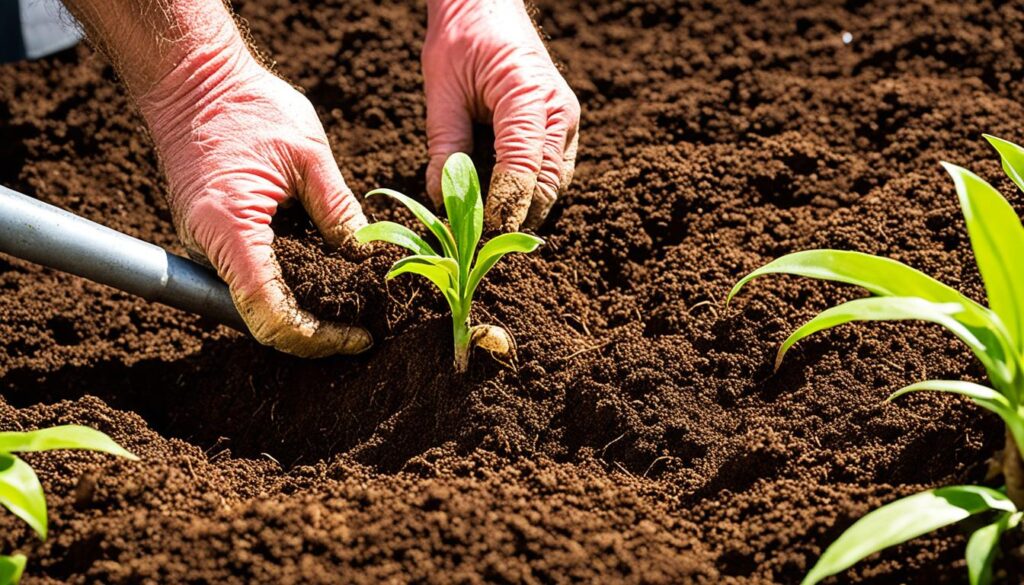
| Planting Technique | Advantages | Disadvantages |
|---|---|---|
| Using Whole Rhizomes | – Quicker growth – Larger harvests |
– Requires more planting material – Limited control over spacing |
| Using Cut Rhizome Pieces | – Maximizes planting material – Allows for precise spacing |
– Slower initial growth – Smaller rhizome yields |
| Pre-sprouting Indoors | – Provides an early start – Enhances germination rates |
– Requires additional indoor space – Requires regular misting |
Care Tips for Ginger Root Growth
Proper care is crucial for the successful growth of ginger roots. By providing the right conditions, you can ensure healthy plants and a bountiful harvest. Here are some essential care tips for ginger root growth:
1. Warmth: Ginger plants thrive in warm environments, so it’s important to provide them with a suitable temperature. During the summer, whether you are growing ginger outdoors or indoors, it’s beneficial to place the plants in a warm and humid area.
2. Humidity: Humidity is another important factor for ginger root growth. If you are growing ginger indoors, placing the plant near a bright windowsill can help simulate the ideal conditions. Additionally, occasional misting with water can create a humid environment that mimics the plant’s natural habitat.
3. Moisture: Adequate moisture levels are essential for ginger plants. It’s important to water the plants regularly, ensuring that the soil is evenly moist. However, be cautious not to overwater, as excessive moisture can lead to root rot. To promote proper drainage, use pots with drainage holes and allow the soil to dry out slightly between waterings.
4. Mulching: Applying a layer of mulch around ginger plants can serve multiple benefits. Mulching helps to conserve moisture in the soil, reducing the frequency of watering required. Additionally, it helps to suppress weed growth, keeping the area around the ginger plants clean and tidy.
Ginger plants require a combination of warmth, humidity, moisture, and proper drainage to thrive. By following these care tips, you can create optimal conditions for ginger root growth and enjoy a successful harvest.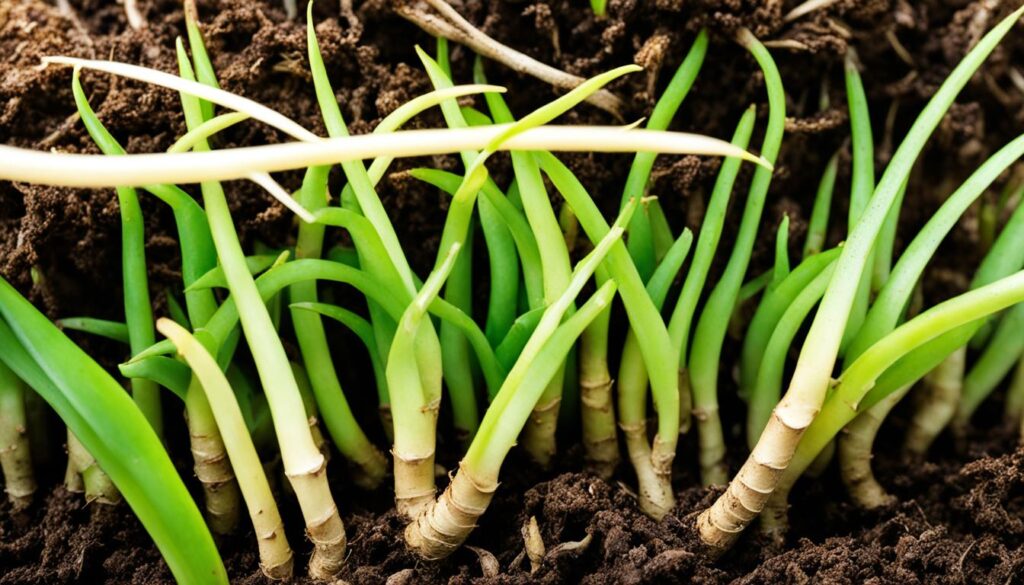
| Care Tips for Ginger Root Growth | Benefits |
|---|---|
| Provide warmth | Creates a favorable environment for ginger plants |
| Maintain humidity | Simulates the plant’s natural habitat and supports growth |
| Ensure proper moisture | Prevents drying out or waterlogging |
| Use mulch | Conserves moisture and suppresses weed growth |
Conclusion
Growing ginger successfully requires replicating its tropical natural habitat as closely as possible. Providing optimal soil conditions, the right temperature range, adequate moisture, and dappled shade is crucial. By following these best practices, gardeners can ensure the best conditions for ginger root growth and enjoy a bountiful harvest.
When it comes to planting ginger, there are two main methods: using whole rhizomes or cutting them into pieces and pre-sprouting indoors for an earlier harvest. Both approaches can be effective, but it’s important to pay careful attention to watering and drainage. Ginger cannot tolerate standing water or drying out completely, so finding the right balance is key.
Remember that ginger thrives in warm temperatures, ideally ranging from 70° to 90°F (21° to 32°C). Additionally, ginger plants appreciate some dappled shade, as it protects them from direct sunlight and helps prevent the soil from drying out too quickly. Creating these optimal conditions will give your ginger the best chance to grow and thrive.
So whether you’re growing ginger in the ground, in containers, or in a greenhouse, make sure to provide it with the right environment. By replicating its tropical natural habitat as closely as possible and paying attention to its specific needs, you can enjoy a bountiful harvest of delicious and aromatic ginger roots.
FAQ
What are the best conditions for ginger root growth?
What are the optimal soil conditions for ginger root growth?
What is the ideal temperature range for ginger root growth?
How important is moisture for ginger root growth?
What are the benefits of dappled shade for ginger root growth?
What are the recommended planting techniques for ginger root growth?
What are the care tips for ginger root growth?
- About the Author
- Latest Posts
Meet Katherine, the creative enthusiast at ByRetreat who infuses her boundless passion for design into every remote workspace she crafts. With an innate sense of creativity and an eye for unconventional beauty, Katherine brings a unique and inspiring perspective to the team.
Katherine’s love for design is infectious, and her ability to think outside the box sets her apart. She believes that true artistry lies in embracing a variety of styles and mixing them harmoniously to create captivating spaces. By combining different textures, colors, and patterns, Katherine weaves a tapestry of creativity that breathes life into each remote workspace.
-

 Vetted5 days ago
Vetted5 days ago15 Best Fillers for Concrete Cracks – Expert Recommendations and Reviews
-

 Vetted7 days ago
Vetted7 days ago15 Best Plants for Large Pots to Transform Your Outdoor Space
-

 Vetted6 days ago
Vetted6 days ago15 Best Fairy Lights to Transform Your Space With Magical Illumination
-

 Vetted1 week ago
Vetted1 week ago15 Best Folding Beds for Small Spaces – Space-Saving Solutions for Comfort and Convenience
-

 Vetted1 week ago
Vetted1 week ago15 Best Waterproof Flooring Options for Your Bathroom – Ultimate Guide & Reviews
-

 Vetted2 weeks ago
Vetted2 weeks ago15 Best Grocery Carts to Make Shopping a Breeze
-

 Vetted22 hours ago
Vetted22 hours ago15 Best Subfloor Options for Your Basement Renovation – Ultimate Guide
-

 Vetted3 weeks ago
Vetted3 weeks ago15 Best Gravel for Driveway: The Ultimate Guide for a Durable and Stunning Entrance


























